Medical Center Financial Model
This 5-Year, 3-Statement Medical Center Financial Model in Excel provides a structured framework to analyze the financial health and profitability.
Financial model for a medical center
The model is composed of three core financial statements: the Income Statement, Cash Flow Statement, and Balance Sheet.
5 Year, 3 Statement model with 6 revenue streams for PAYG services, and a 6 Tier Subscriptions for medical insurance incomes.
‘Managed Service Agreements’. Build Your MSA book as quickly as possible.
You would typically sell your services at tiered 12-month agreements that increase in price as SLAs (Service Level Agreements) and monthly consulting hours scale upwards. See below for examples.
Income Statement (Profit & Loss Statement)
The Income Statement summarizes the medical center’s revenues, expenses, and profitability over a specific period.
Key Components:
Revenue Streams:
Patient Services Revenue: Income from consultations, surgeries, diagnostics, and treatments. This can be broken down by department (e.g., cardiology, radiology, emergency care).
Ancillary Services Revenue: Income from lab tests, imaging, pharmacy, and other non-core services.
Other Revenue: Income from grants, donations, or partnerships.
Cost of Services (COS):
Direct Medical Costs: Costs directly tied to patient care, such as medical supplies, drugs, and lab materials.
Labor Costs: Salaries and benefits for medical staff (doctors, nurses, technicians).
Equipment Maintenance: Costs for maintaining medical equipment.
Operating Expenses:
Administrative Costs: Salaries for non-medical staff (HR, finance, IT).
Facility Costs: Rent, utilities, and maintenance of the medical center.
Marketing and Outreach: Costs for advertising, community programs, and patient acquisition.
Insurance and Legal Fees: Malpractice insurance, legal compliance, and other professional fees.
Depreciation and Amortization:
Depreciation of medical equipment and amortization of intangible assets (e.g., software licenses).
Operating Income:
Revenue minus COS and operating expenses.
Non-Operating Items:
Interest Income/Expense: Income from investments or interest on loans.
Other Income/Expenses: Grants, donations, or one-time items.
Net Income:
Operating income plus/minus non-operating items, minus taxes.
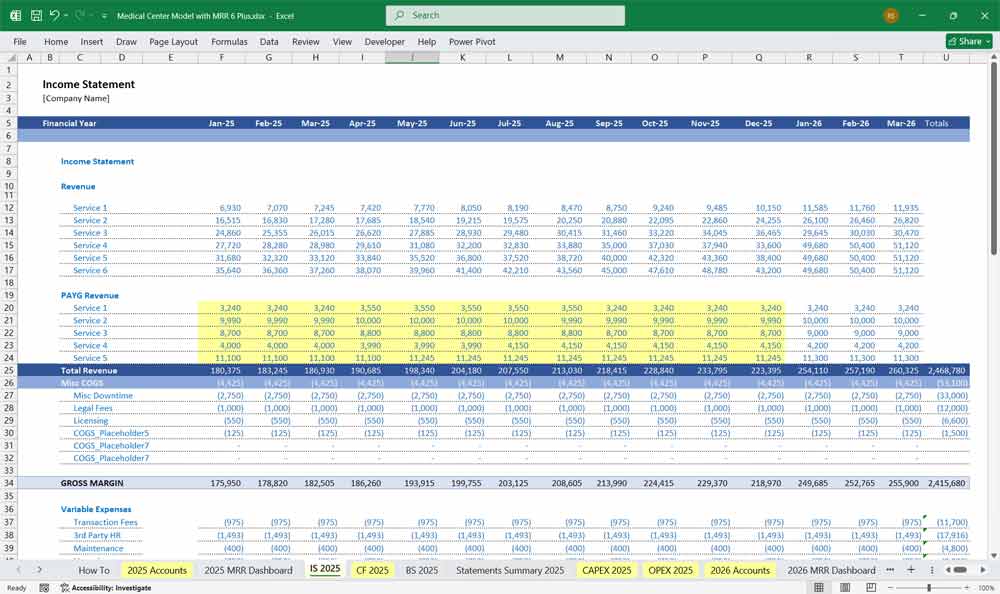
Medical Center Cash Flow Statement
The Cash Flow Statement tracks the inflow and outflow of cash, ensuring the medical center has sufficient liquidity to operate.
Key Components:
Cash Flow from Operating Activities:
Cash Receipts from Patients: Payments received from patients or insurers.
Cash Payments to Suppliers: Payments for medical supplies, drugs, and equipment.
Payroll Payments: Salaries and benefits paid to staff.
Other Operating Expenses: Payments for utilities, rent, and other overheads.
Adjustments for Non-Cash Items: Add back depreciation and amortization.
Cash Flow from Investing Activities:
Capital Expenditures (CapEx): Cash spent on purchasing or upgrading medical equipment, facilities, or technology.
Investments: Cash used for or generated from investments (e.g., marketable securities).
Cash Flow from Financing Activities:
Debt Proceeds: Cash received from loans or lines of credit.
Debt Repayments: Principal payments on loans.
Equity Financing: Cash received from investors or shareholders.
Dividends: Cash paid to shareholders (if applicable).
Net Change in Cash:
Sum of cash flows from operating, investing, and financing activities.
Ending Cash Balance:
Starting cash balance plus net change in cash.
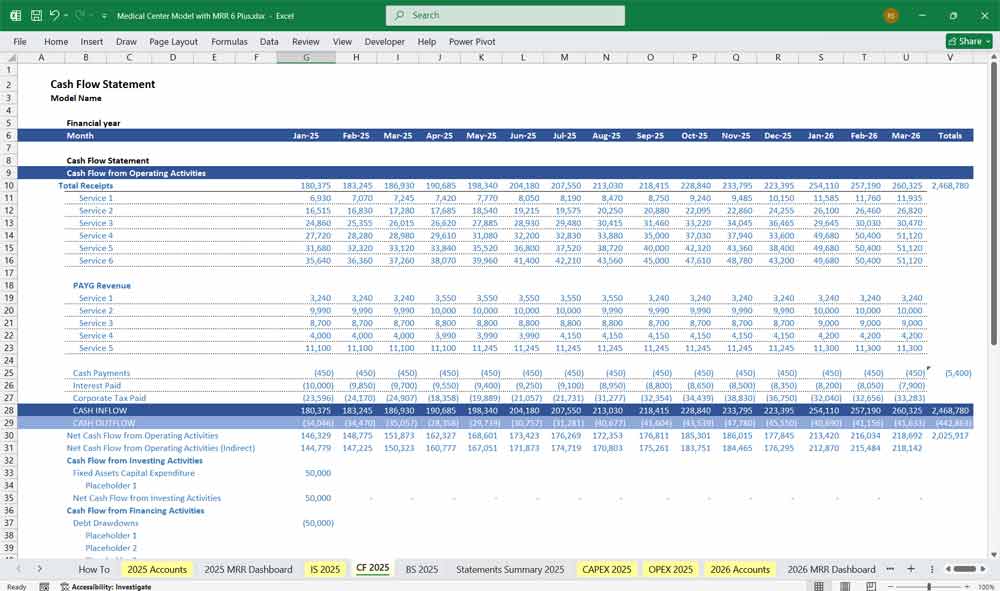
Medical Center Balance Sheet
The Balance Sheet provides a snapshot of the medical center’s financial position at a specific point in time, showing assets, liabilities, and equity.
Key Components:
Assets:
Current Assets:
Cash and Cash Equivalents: Liquid assets available for operations.
Accounts Receivable: Amounts owed by patients or insurers.
Inventory: Medical supplies, drugs, and other consumables.
Non-Current Assets:
Property, Plant, and Equipment (PPE): Medical equipment, buildings, and furniture (net of depreciation).
Intangible Assets: Software licenses, patents, or trademarks.
Liabilities:
Current Liabilities:
Accounts Payable: Amounts owed to suppliers.
Accrued Expenses: Unpaid salaries, utilities, or taxes.
Short-Term Debt: Loans or credit lines due within a year.
Non-Current Liabilities:
Long-Term Debt: Loans or bonds payable beyond one year.
Deferred Revenue: Payments received in advance for services.
Equity:
Retained Earnings: Cumulative net income retained in the business.
Shareholder Equity: Capital contributed by owners or investors.
Balance Check:
Total Assets = Total Liabilities + Equity.
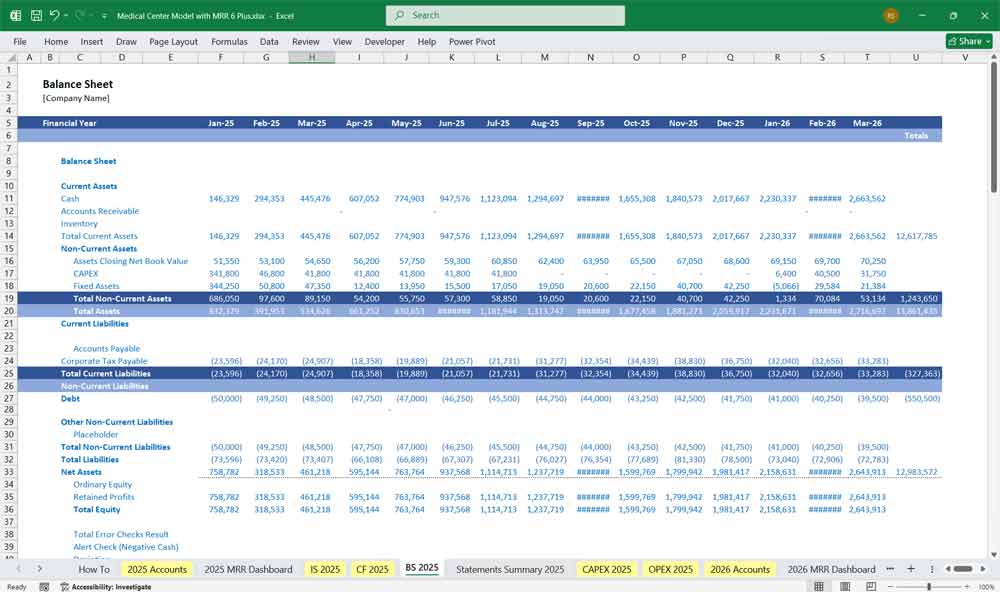
Key Financial Metrics for a Medical Center
- Gross Profit Margin = (Gross Profit / Revenue) × 100
- Operating Profit Margin (EBIT Margin) = (EBIT / Revenue) × 100
- Net Profit Margin = (Net Income / Revenue) × 100
- Return on Assets (ROA) = (Net Income / Total Assets) × 100
- Return on Equity (ROE) = (Net Income / Shareholder Equity) × 100
- Debt-to-Equity Ratio = (Total Debt / Shareholder Equity)
- Inventory Turnover = (COGS / Average Inventory)
- Days Sales Outstanding (DSO) = (Accounts Receivable / Revenue) × 365
When structuring services for a medical center, it’s important to organize them in a way that aligns with customer needs, market demand, and operational efficiency.
Service Line Categorization for a Medical Center
A Medical Center typically offers a wide range of services for different clients, including specialty clinics, diagnostic imaging, and surgical services.
1. Primary Medical Center Care Services:
General health check-ups, vaccinations, and routine screenings.
– Sub-points: Preventative care, chronic disease management, health education, patient monitoring.
2. Specialty Medical Clinics:
Dedicated services for cardiology, dermatology, or orthopedics.
– Sub-points: Advanced diagnostics, specialized treatments, expert consultations, tailored care plans.
3. Emergency Medical Care:
24/7 emergency medical services for critical conditions.
– Sub-points: Trauma care, urgent treatment, life-saving interventions, rapid response.
4. Medical Center Diagnostic Imaging:
X-rays, MRIs, CT scans, and ultrasounds.
– Sub-points: Accurate diagnosis, non-invasive procedures, advanced technology, timely results.
5. Laboratory Medical Services:
Blood tests, urine analysis, and pathology services.
– Sub-points: Disease detection, health monitoring, quick turnaround, precision testing.
6. Surgical Medical Services:
Outpatient and inpatient surgical procedures.
– Sub-points: Minimally invasive techniques, pre-op consultations, post-op care, state-of-the-art facilities.
7. Women’s Health Services Center:
Gynecology, mammograms, and prenatal care.
– Sub-points: Reproductive health, family planning, breast cancer screening, maternal care.
8. Pediatric Medical Care:
Health services for infants, children, and adolescents.
– Sub-points: Growth monitoring, immunizations, developmental assessments, pediatric emergencies.
9. Mental Health Center Services:
Counseling, therapy, and psychiatric care.
– Sub-points: Stress management, addiction treatment, behavioral therapy, crisis intervention.
10. Medical Rehabilitation Services:
Physical therapy, occupational therapy, and speech therapy.
– Sub-points: Injury recovery, mobility improvement, chronic pain management, post-surgery rehab.
11. Chronic Medical Disease Management:
Programs for diabetes, hypertension, and asthma.
– Sub-points: Personalized care plans, regular monitoring, patient education, lifestyle coaching.
12. Geriatric Medical Care:
Specialized services for elderly patients.
– Sub-points: Age-related condition management, fall prevention, memory care, palliative support.
13. Nutrition and Medical Dietetics:
Personalized diet plans and nutritional counseling.
– Sub-points: Weight management, disease-specific diets, wellness coaching, meal planning.
14. Telemedicine Center:
Virtual consultations and remote monitoring.
– Sub-points: Accessibility, convenience, follow-up care, reduced wait times.
15. Preventive Health Medical Programs:
Health screenings and wellness workshops.
– Sub-points: Early disease detection, health risk assessments, lifestyle improvement, community outreach.
16. Travel Medicine:
Vaccinations and health advice for travelers.
– Sub-points: Destination-specific immunizations, travel safety tips, emergency preparedness, post-travel check-ups.
17. Allergy and Medical Immunology:
Testing and treatment for allergies and immune disorders.
– Sub-points: Allergy shots, immune therapy, symptom management, personalized treatment plans.
18. Sleep Medicine:
Diagnosis and treatment of sleep disorders.
– Sub-points: Sleep studies, CPAP therapy, insomnia treatment, sleep hygiene education.
19. Oncology Medical Services:
Cancer diagnosis, treatment, and support.
– Sub-points: Chemotherapy, radiation therapy, survivorship programs, palliative care.
20. Home Health Medical Care:
Medical services provided at patients’ homes.
– Sub-points: Post-hospitalization care, chronic condition management, elderly support, family caregiver training.
4 Sub-Points for a Medical Center:
1. Comprehensive Care:
Offer a wide range of services under one roof for patient convenience.
2. Patient-Centered Approach:
Focus on personalized care plans and patient satisfaction.
3. Advanced Technology:
Utilize cutting-edge medical equipment and techniques for accurate diagnosis and treatment.
4. Multidisciplinary Teams:
Collaborate with specialists, nurses, and support staff to provide holistic care.
6-tier subscription model for a medical center
Generate recurring revenue, improve patient loyalty, and provide tailored healthcare services. Each tier should offer increasing levels of benefits, catering to different patient needs and budgets.
Tier 1: Basic Medical Center Wellness Plan
Target Audience: Individuals seeking preventive care and basic health monitoring.
Features:
Annual Health Check-Up: One comprehensive health screening per year (e.g., blood tests, BMI, blood pressure, cholesterol).
Discounts on Services: 10% discount on consultations, lab tests, and imaging services.
Health Newsletter: Monthly email with wellness tips and health updates.
Telemedicine: 2 free telemedicine consultations per year.
Vaccination Reminders: Notifications for flu shots and other vaccinations.
Price: 10–10–20/month.
Tier 2: Primary Medical Center Care Plus
Target Audience: Patients who want regular access to primary care services.
Features:
Unlimited Primary Care Visits: No copay for in-person or telemedicine visits with a primary care physician.
Preventive Care: Annual health check-up and 2 additional screenings (e.g., diabetes, thyroid).
Discounts on Services:
15% discount on specialist consultations, lab tests, and imaging.
Health Coaching: Access to a health coach for lifestyle and wellness advice.
Priority Scheduling: Faster appointment booking.
Price: 30–30–50/month.
Tier 3: Family Medical Center Care Plan
Target Audience: Families looking for comprehensive healthcare coverage.
Features:
Coverage for Up to 4 Family Members: Includes all Tier 2 benefits for each member.
Pediatric Care: Unlimited visits to a pediatrician.
Annual Dental Check-Up: One free dental cleaning and exam per family member.
Mental Health Support: 4 free counseling sessions per year per family member.
Discounts on Services: 20% discount on specialist consultations, lab tests, and imaging.
Price: 80–80–120/month.
Tier 4: Chronic Medical Center Care Management
Target Audience: Patients with chronic conditions (e.g., diabetes, hypertension).
Features:
Personalized Care Plan: Tailored treatment plan with regular follow-ups.
Unlimited Specialist Visits: No copay for visits to specialists (e.g., endocrinologist, cardiologist).
Remote Monitoring: Free wearable device (e.g., glucose monitor, blood pressure cuff) with data synced to the medical center.
Medication Management: Discounts on prescription drugs and free delivery.
24/7 Nurse Hotline: Access to a nurse for medical advice.
Quarterly Health Reviews: In-depth reviews of health progress with a care coordinator.
Price: 150–150–200/month.
Tier 5: Executive Medical Center Health Plan
Target Audience: Busy professionals seeking premium, concierge-level care.
Features:
Comprehensive Annual Health Assessment: Advanced screenings (e.g., cardiac stress test, cancer markers).
Concierge Service: Dedicated care coordinator for scheduling and follow-ups.
Same-Day Appointments: Guaranteed same-day or next-day appointments.
Executive Wellness Programs: Access to nutritionists, personal trainers, and stress management programs.
Global Coverage: Telemedicine and emergency support while traveling.
Discounts on Services: 30% discount on all medical services.
Price: 300–300–500/month.
Tier 6: Platinum Medical Center Elite Plan
Target Audience: High-net-worth individuals seeking the highest level of personalized care.
Features:
All Tier 5 Benefits: Includes everything in the Executive Health Plan.
24/7 On-Demand Doctor: Access to a private physician for in-home visits or virtual consultations.
Advanced Diagnostics: Access to cutting-edge diagnostic tools (e.g., genetic testing, MRI).
Luxury Amenities: Access to spa services, private recovery suites, and gourmet meals during hospital stays.
Global Medical Evacuation: Emergency medical evacuation services worldwide.
Bespoke Wellness Retreats: Annual all-inclusive wellness retreats tailored to individual health goals.
Price: $1,000+/month.
Additional Considerations:
Flexibility: Allow patients to upgrade, downgrade, or cancel subscriptions with minimal hassle.
Trial Periods: Offer a 30-day free trial for new subscribers to build trust.
Bundling: Provide discounts for annual subscriptions paid upfront.
Corporate Plans: Offer group subscriptions for businesses to cover their employees.
Technology Integration: Use a user-friendly app to manage subscriptions, book appointments, and access telemedicine services.
This 6-tier subscription model ensures that the medical center can cater to a wide range of patients while generating predictable, recurring revenue. It also enhances patient satisfaction by offering tailored healthcare solutions.
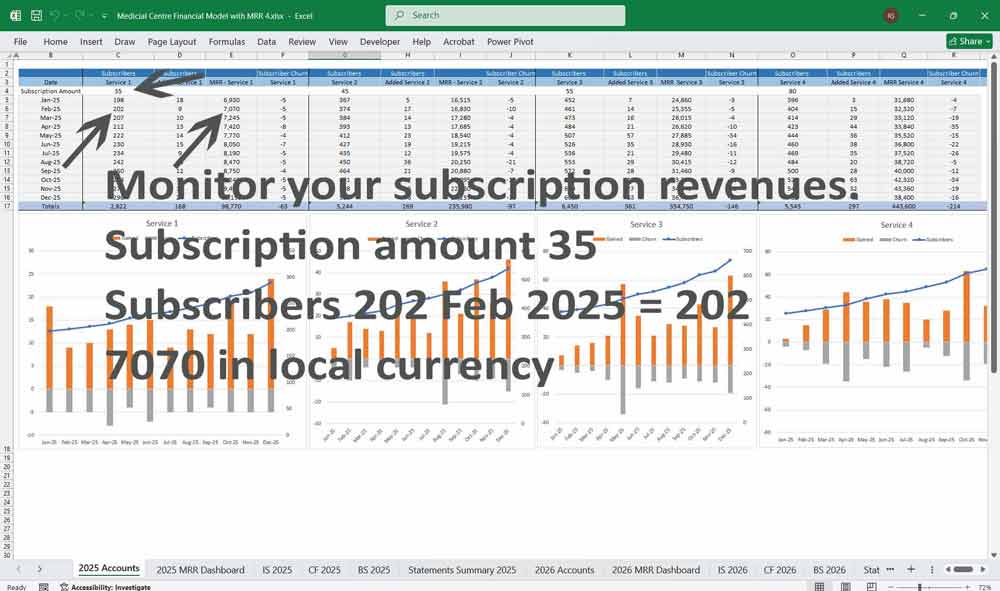
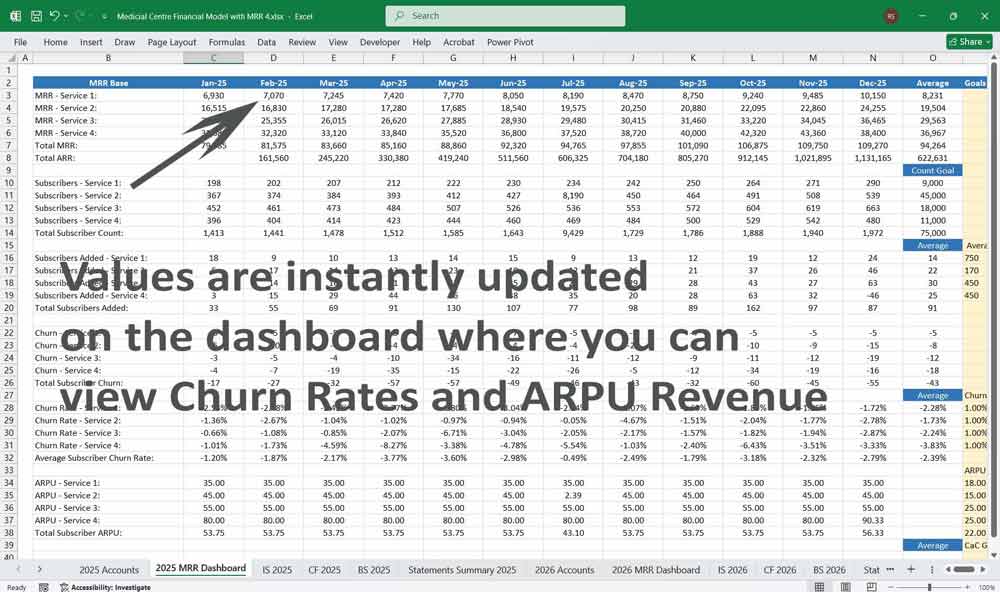
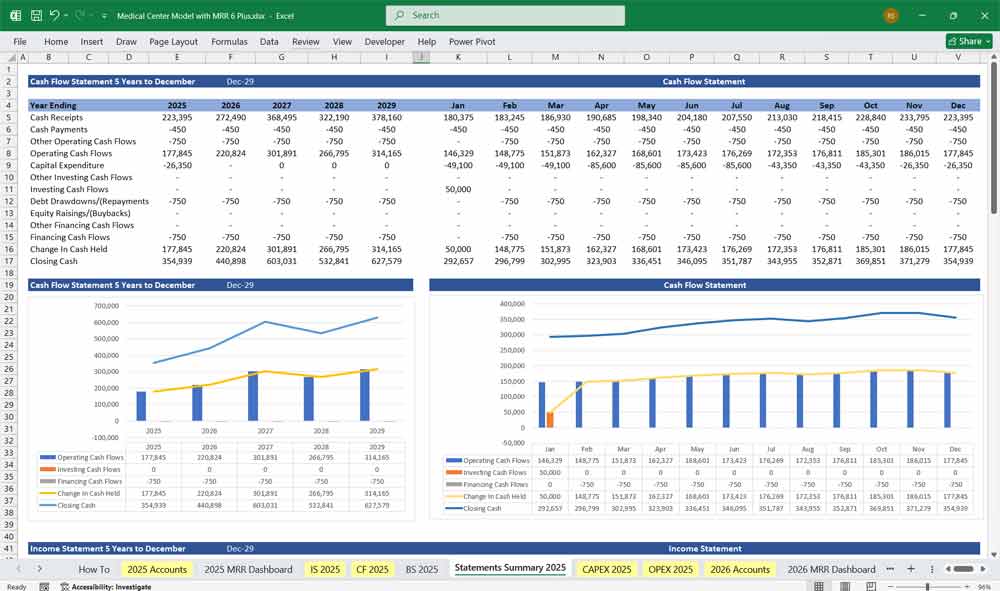
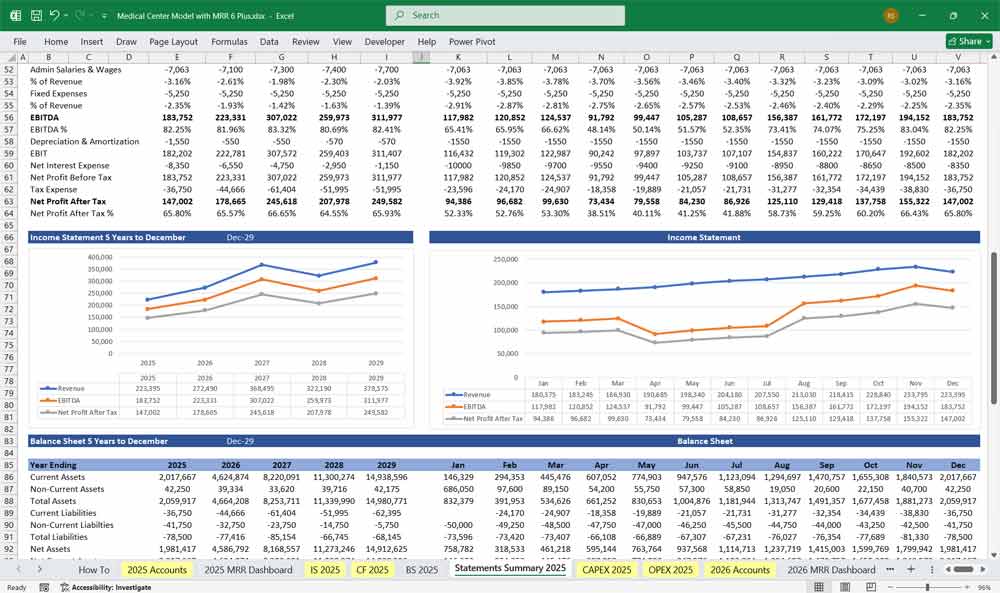
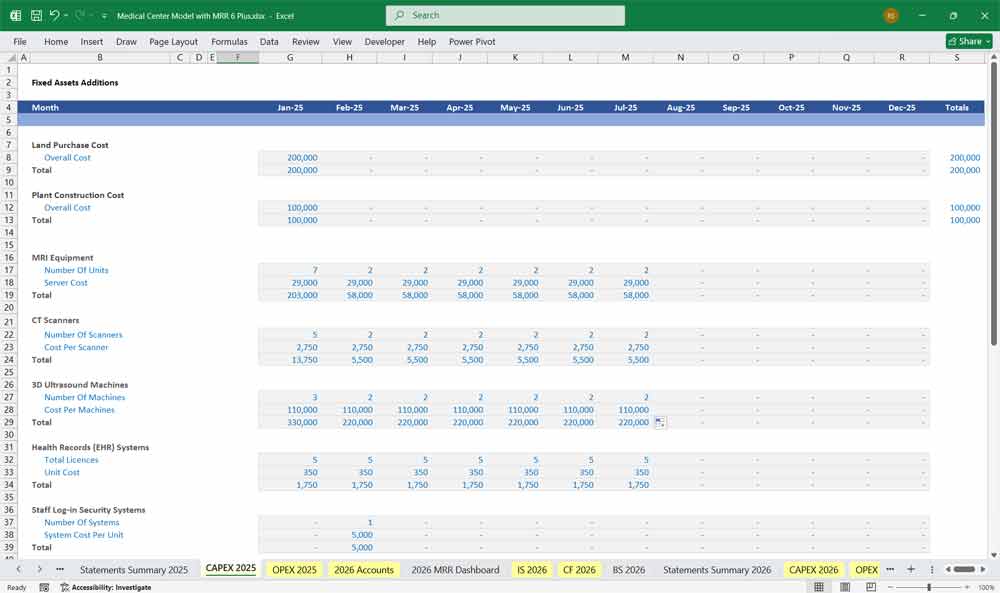
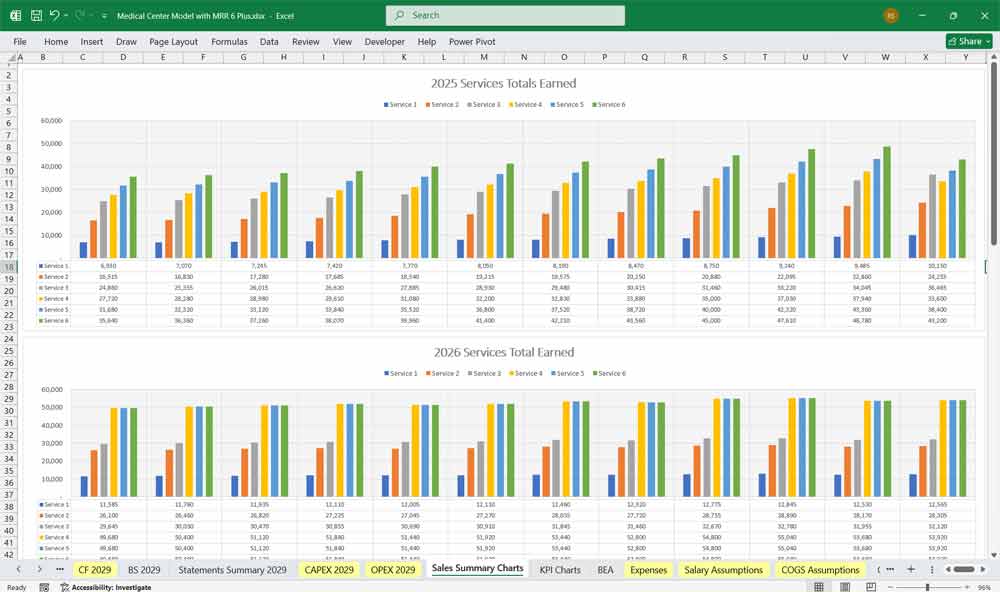
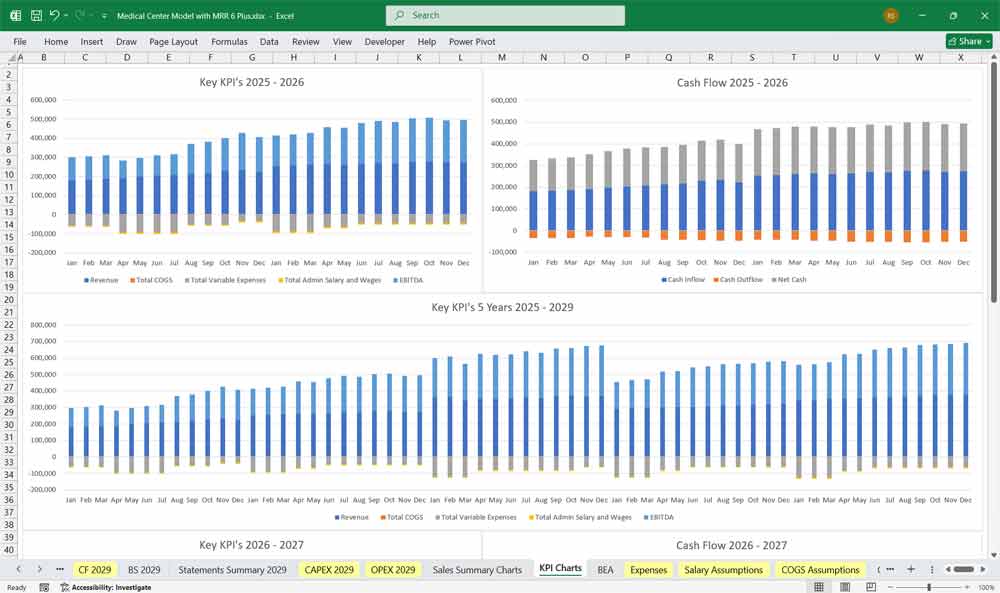
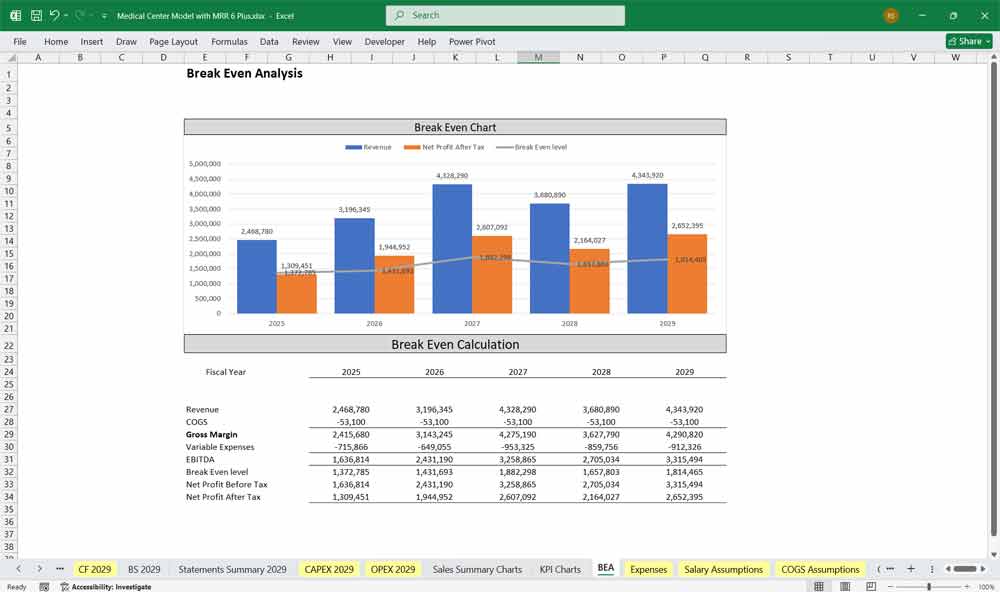
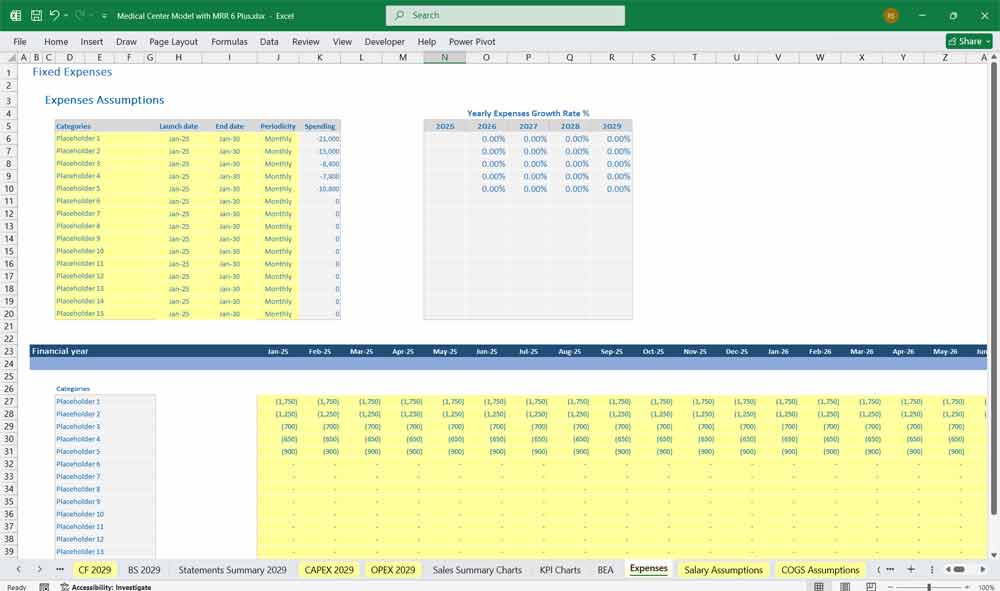
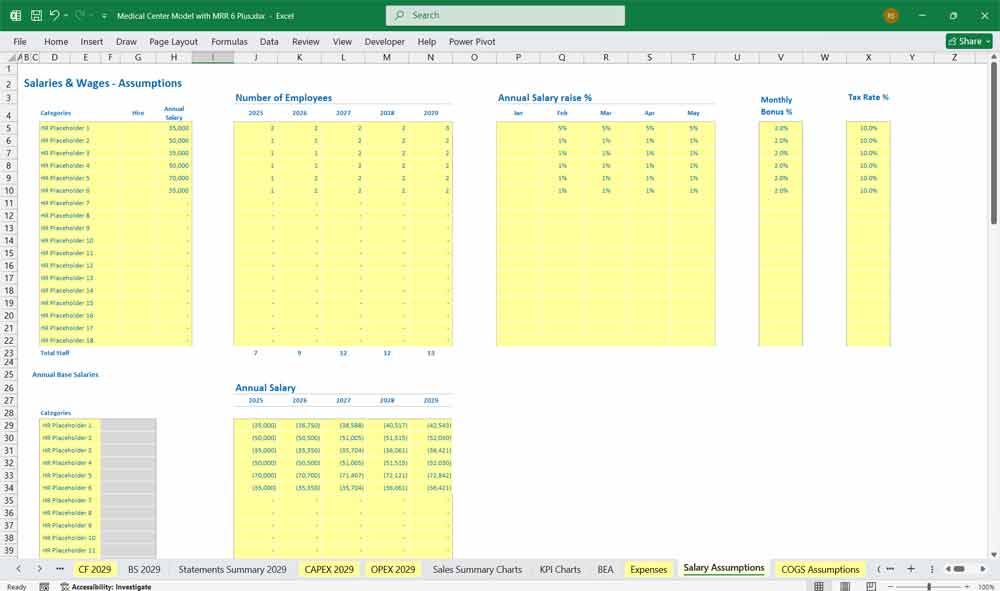
Additional Considerations for a Financial Model
Key Assumptions:
Patient volume growth rate.
Average revenue per patient.
Reimbursement rates from insurers (e.g., Medicare, Medicaid, private insurers).
Inflation rates for medical supplies and labor costs.
Sensitivity Analysis:
Test how changes in key assumptions (e.g., patient volume, reimbursement rates) impact financial performance.
Scenario Analysis:
Create best-case, base-case, and worst-case scenarios to assess financial resilience.
Key Performance Indicators (KPIs):
Revenue per Patient: Total revenue divided by the number of patients.
Operating Margin: Operating income as a percentage of revenue.
Days Sales Outstanding (DSO): Average time to collect receivables.
Debt-to-Equity Ratio: Total debt divided by total equity.
- This Medical Center financial model provides a comprehensive framework for analyzing the medical center’s financial health, planning for growth, and making informed decisions.
Download Link On Next Page
